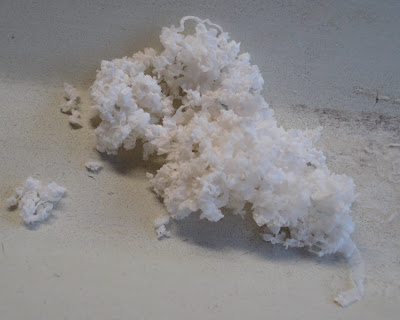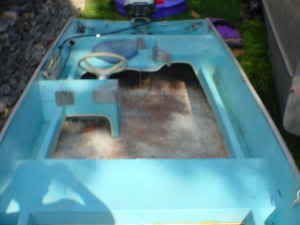i386
Captain
- Joined
- Aug 24, 2004
- Messages
- 3,548
Re: i386 Boat Restoration. (Crosby Sled)
... continued

Trusty surform tool.

Epoxy shavings.
The first thing I'm doing is removing the big repair on the bow and filling any big spots and gouges.
The repair on the bow was made by one of the previous owners using a bondo fiberglass repair kit. There were 3 layers of cloth. I thought I'd have to grind all this off but turns out is was pretty easy. Using the surform tool, I started working through the glass on the keel near the bow. It didn't take long to cut down to the gelcoat. This exposed the edge of the cloth so that I could get a chisel under it. Most of the cloth got chiseled and pulled off. The rest, got sanded.
I've got a good many spots to fill. Most were where I made repairs from inside the hull. Some were just gouges from stumps and rocks. I'm filling with epoxy resin with 3M glass bubbles thickened with some cabosil. The glass bubbles makes the epoxy fairly easy to sand. Trust me, you don't want to sand cured pure epoxy resin. The stuff is hard as a rock.
So what I've done is glob on a good bit of this thickend resin onto the spots I'm working on. Then after a few hours, I come back with the surform tool. You want to do this before the resin fully cures. It should be pretty rigid, but still soft enough that it would gum up sandpaper. I work the surform tool over the resin and it just shaves the excess away. That way I won't have to use the sander to remove a lot of material.
I made a thin sanding block to reach where my sander won't. Luckily, I won't have to use it too much as the surfaces of this hull are pretty forgiving to sand.
So far, this stage has been some of the easiest work I've done. I'm enjoying it.
... continued
Trusty surform tool.
Epoxy shavings.
The first thing I'm doing is removing the big repair on the bow and filling any big spots and gouges.
The repair on the bow was made by one of the previous owners using a bondo fiberglass repair kit. There were 3 layers of cloth. I thought I'd have to grind all this off but turns out is was pretty easy. Using the surform tool, I started working through the glass on the keel near the bow. It didn't take long to cut down to the gelcoat. This exposed the edge of the cloth so that I could get a chisel under it. Most of the cloth got chiseled and pulled off. The rest, got sanded.
I've got a good many spots to fill. Most were where I made repairs from inside the hull. Some were just gouges from stumps and rocks. I'm filling with epoxy resin with 3M glass bubbles thickened with some cabosil. The glass bubbles makes the epoxy fairly easy to sand. Trust me, you don't want to sand cured pure epoxy resin. The stuff is hard as a rock.
So what I've done is glob on a good bit of this thickend resin onto the spots I'm working on. Then after a few hours, I come back with the surform tool. You want to do this before the resin fully cures. It should be pretty rigid, but still soft enough that it would gum up sandpaper. I work the surform tool over the resin and it just shaves the excess away. That way I won't have to use the sander to remove a lot of material.
I made a thin sanding block to reach where my sander won't. Luckily, I won't have to use it too much as the surfaces of this hull are pretty forgiving to sand.
So far, this stage has been some of the easiest work I've done. I'm enjoying it.
























